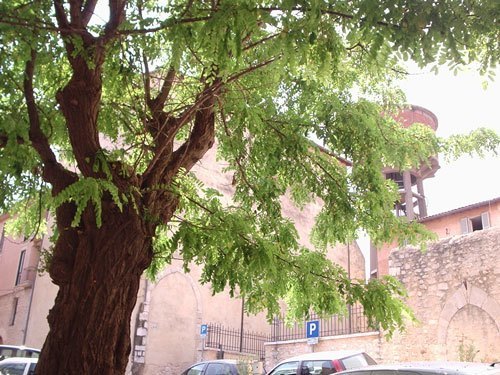Black Locust
Scientific Classification
| Kingdom: | Plantae |
| Genus: | Robinia |
| Family: | Fabaceae |
| Species: | R.Seudoacacia |
| Order: | Fabales |

Photo by: AnRo0002
The black locust tree is also known as False Acacia. The Black Locust tree is a genus of Robinia. In the Eastern U.S, this tree is a honey plant. It has been planted in Italy, France, and European Nations. In Italy and France Black locust is the source of monofloral honey. The trunk of the black locust tree is about 52 meters tall. It has thick black bark. The flowering of the black locust tree starts after 140 days of growing. The blooming period is very short. Every year these trees do not produce honey. These trees are the most valuable for their timber and can be planted in the middle and northern states. Black locust is a medium sized tree. Many animals of wildlife including squirrels, rabbits, pheasants and mourning doves can eat the seeds of the pods, without any ill effect. But, for humans and cattle, the leaves, inner bark and seeds are toxic, they can never be eaten. Black locust tree can survive in harsh winter season and also in a drought.
Habitat
Black locust tree requires full sunlight. It is found in older fields, roadsides and in degraded woods. Black locust ranges from the lower slopes of the Appalachian Mountains to the edges of forests Indiana, Missouri and Southern Illinois. This tree is naturalized in the United States and in parts of Europe. It is also being planted in temperate climate areas and promoted by nurseries and by federal and state agencies.
Anatomy
The leaves of black locust are odd-pinnate, parallel and compound. The leaves are 21-40 inches long. The leaves have slender, hairy petioles. In the fall, the leaves turn yellow. The leaflets of the black locust tree are oval in shape with 3 to 9 pairs of leaflets and at the tip, a single leaflet occurs. Looking from above, leaflets are dark green. Their flowers are pea like, white and fragrant. The fruit is reddish brown pods, flat and these pods hang in clusters or singly. Each pod may contain 4 to 8 seeds. During the winter season, pods may remain on the tree. The flowers of black locust produce honey from their nectar. The flowers are fragrant and they attract bees. It cannot tolerate shade. At maturity, black locust can reach about 40-100 feet high. The bark of the tree has deep furrows and is dark gray in color. It grows in late spring season. Their flowers are pollinated by humming bird and bees. The seeds of the tree are eaten by mourning dove, Northern Bobwhite, Eastern cottontail, white tailed deer, squirrels and wild turkey.
Soil

Photo by: Mirko Fontemaggi
These trees prefer rocky and sandy soil. Black locust tree is found in distributed areas. Well drained and fertile soil is also ideal for black locust.
Uses
The wood of this tree is resistant to rot, durable and hard. The wood is used in the making of fence pots, furniture, small watercraft, paneling, mine timber, boat building, railroad ties and flooring. In North America, it is one of the hardest and heaviest woods. For, wood burning stoves it is also used as firewood because wood of this tree burns slowly, with less visible smoke and flame. Even when the wood of the black locust tree is wet, it has the ability to burn. As it grows rapidly, it is also used as firewood tree.
Pests and Pesticides
Magacyllene Robiniae attacks the black locust. It is harmful. It can not only eat the tree’s wood, but also weakens the tree. It can damage the whole tree. This pest allows other pests to attack on the tree. The Odontota Dorsalis insect is also harmful for black locust. Triclopyr solution in basal oil is good for the tree.

Having discovered a fondness for insects while pursuing her degree in Biology, Randi Jones was quite bugged to know that people usually dismissed these little creatures as “creepy-crawlies”.







